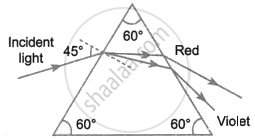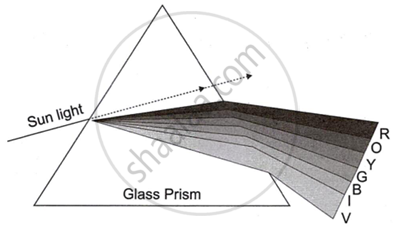Advertisements
Advertisements
प्रश्न
A student traces the path of a ray of light through a triangular glass prism for different values of angle of incidence. On analyzing the ray diagrams, which one of the following conclusions is he likely to draw?
(A) The emergent ray is parallel to the incident ray.
(B) The emergent ray bends at an angle to the direction of the incident ray.
(C) The emergent ray and the refracted ray are at right angles to each other.
(D) The emergent ray is perpendicular to the incident ray.
उत्तर
(B) The emergent ray bends at an angle to the direction of the incident ray.
In refraction of light through a glass prism, there is deviation or change in the path of light passing through the prism.
APPEARS IN
संबंधित प्रश्न
Describe an activity to show that colours of white light splitted by a glass prism can be recombined to get white light by another identical glass prism. Also draw ray diagram to show the recombination of the spectrum of white light.
The speed of light in air or vacuum is
State the speed of light in (a) air, (b) water, and (c) glass
Which characteristic property of light is responsible for the blue colour of the sky?
Suggest one way, in each case, by which we can detect the presence of Infrared radiations.
Write an Explanation.
Critical angle
When white light enters a glass prism from the air, the angle of deviation is least for ____________.
The phenomena of light involved in the formation of rainbow are ______.
A ray of light is incident at 45° on an equilateral prism in the diagram below.

- Name the phenomenon exhibited by the ray of light when it enters and emerges out of the prism.
- State the cause of the above phenomenon mentioned by you.
Observe the given diagram and answer the questions:

- Name the process shown in the figure.
- Name the colour that deviates the most.
- Name the colour that deviates the least.
- Name any one phenomenon in nature which is based on the above process.
- Define ‘spectrum’.
